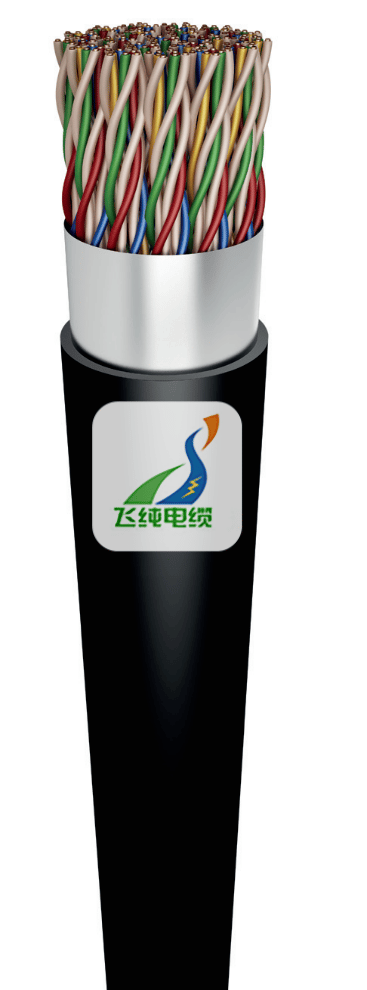Type YnTKGX Underground Mine Telecommunications Cable
Designed to meet the stringent requirements of mine telecommunication networks, signaling systems, and mining equipment, this cable ensures robust performance even in harsh and damp conditions.


Conductors:
The cable features copper conductors with a diameter of 0.8 mm, each insulated with high-quality polyethylene. This provides excellent dielectric properties and environmental resistance.
Conductor Identification:
Each pair of conductors is clearly identified through a standardized color-coding system. Typically, the first pair is marked with red and blue (representing “licznikowa” and “kierunkowa” roles), while the next pair is green and yellow. Additional pairs use a natural color, simplifying installation and troubleshooting in complex mining telecommunication systems.
Filler and Moisture Barrier:
A gel filler is incorporated within the cable to maintain structural integrity, while a laminated aluminum foil barrier prevents moisture ingress—an essential feature in damp underground conditions.
Outer Coating:
The cable is jacketed with a flame-retardant polwinit material (a specialized PVC compound that inhibits flame spread). The outer coating is uniformly black (RAL 9005), ensuring both aesthetic consistency and long-term durability.
Electrical and Mechanical Characteristics
Resistance and Capacitance:
Maximum Pair Resistance: 73.6 Ω/km
Minimum Insulation Resistance: 5000 MΩ×km
Effective Capacitance: 60 µF/km (measured at 800 Hz)
These characteristics ensure minimal signal loss and high-quality data transmission over long distances.
Bending Radius:
The cable can be safely bent to a minimum radius of 15 times its external diameter (15D), allowing for flexible installation without compromising the cable’s integrity.
Temperature Range:
Operating Temperature: –5°C to +50°C
Installation Temperature: –15°C to +60°C
These ranges make the cable suitable for the variable thermal conditions encountered in mining environments.
Available Configurations
The cable is offered in multiple pair configurations to suit different system requirements:
2x2 Configuration:
Pairs: 2 pairs in one layer
Coating Thickness: 1.4 mm
External Diameter: 7.7 mm
5x2 Configuration:
Pairs: 5 pairs in one layer
Coating Thickness: 1.8 mm
External Diameter: 11.0 mm
16x2 Configuration:
Layering: 5 pairs in the first layer, 11 pairs in the second layer
Coating Thickness: 1.8 mm
External Diameter: 16.4 mm
33x2 Configuration:
Layering: 5 pairs in the first layer, 11 pairs in the second layer, and 17 pairs in the third layer
Coating Thickness: 1.4 mm
External Diameter: 20.4 mm
Applications
This cable is ideally suited for:
Telecommunications Networks:
Providing reliable data and voice communication channels in mining tunnels and shafts.Signaling Systems:
Ensuring precise and uninterrupted signaling for safety and operational control.Mining Equipment:
Integrating with various mining devices, enhancing overall operational efficiency in underground settings.

Frequently Asked Questions (FAQ)
Q: What is the Type YnTKGX Mine Telecommunications Cable?
A: It is a high-performance cable designed specifically for underground mining communications, supporting voice, data, and signaling applications.Q: What environments is this cable intended for?
A: It is engineered for harsh, damp underground mining environments, including tunnels, shafts, and mining equipment installations.Q: What material are the conductors made of?
A: The cable uses high-quality copper conductors with a diameter of 0.8 mm.Q: What type of insulation is used on the conductors?
A: The conductors are insulated with polyethylene (PE), offering excellent dielectric properties.Q: How are the conductor pairs identified?
A: Each pair is identified by standard color-coding (red, blue, green, yellow, and natural for additional pairs) to simplify wiring and troubleshooting.Q: What is the purpose of the gel filler in the cable?
A: The gel filler helps maintain the cable’s shape and protects against mechanical stresses during installation and operation.Q: How does the cable prevent moisture ingress?
A: A laminated aluminum foil barrier acts as a damp-proof seal to prevent moisture from penetrating the cable.Q: What material is used for the inner coating?
A: The inner coating is made of PVC (polwinit), which provides additional insulation and protection.Q: What color is the inner coating?
A: The inner coating is black, conforming to RAL 9005 standards.Q: What is the outer coating made of?
A: The outer jacket is made of flame-retardant polwinit, ensuring high fire resistance.Q: What is the color of the outer coating?
A: Like the inner coating, the outer jacket is black (RAL 9005).Q: What is the maximum loop resistance of the cable?
A: The maximum pair resistance is 73.6 Ω/km, ensuring minimal signal loss over long distances.Q: What is the minimum insulation resistance specified for the cable?
A: The cable features a minimum insulation resistance of 5000 MΩ×km, ensuring safe operation.Q: What is the effective capacitance of the cable?
A: It has an effective capacitance of 60 µF/km (at 800 Hz), which is critical for signal integrity.Q: What is the minimum bending radius for this cable?
A: The minimum bending radius is 15 times the external diameter (15D), allowing for flexible installation without damage.Q: What is the operating temperature range for this cable?
A: It operates effectively between –5°C and +50°C.Q: What is the installation temperature range?
A: The cable can be installed in temperatures ranging from –15°C to +60°C.Q: For which applications is the cable primarily used?
A: It is intended for telecommunications networks, signaling systems, and integration with mining equipment in underground mines.Q: How does the cable’s design benefit mining communications?
A: Its robust construction, moisture protection, and low electrical losses ensure reliable communications in challenging mining conditions.Q: What certifications or standards does the cable meet?
A: The cable complies with ZN 86/MH 80iMP 13 K12098 and specification TT1-6410, ensuring it meets rigorous industry standards.Q: How does the laminated aluminum foil benefit the cable?
A: It provides an effective barrier against moisture, crucial for maintaining performance in damp underground environments.Q: Can this cable handle high electromagnetic interference (EMI)?
A: Yes, its design minimizes EMI, ensuring clear and reliable signal transmission.Q: How is the cable structured in terms of pair configurations?
A: The cable is available in various configurations, including 2x2, 5x2, 16x2, and 33x2, to suit different communication requirements.Q: What does the “2x2” configuration mean?
A: It indicates the cable contains 2 pairs arranged in a single layer, ideal for simple communication needs.Q: What advantages does a 5x2 configuration offer?
A: A 5x2 configuration provides five pairs in one layer, offering more channels for complex systems while keeping the cable compact.Q: What are the benefits of multi-layer configurations like 16x2 and 33x2?
A: Multi-layer configurations allow for more pairs without increasing the overall cable diameter significantly, ideal for high-density communications.Q: How does the cable’s construction enhance its durability in mining conditions?
A: Its robust materials, moisture barriers, and flame-retardant properties make it resistant to mechanical stresses, fire, and environmental degradation.Q: Why is low capacitance important in a telecommunications cable?
A: Low capacitance reduces signal delay and distortion, ensuring high-quality data transmission over long distances.Q: How does the cable’s insulation contribute to its performance?
A: The high-quality polyethylene insulation provides excellent electrical performance and environmental protection.Q: Is this cable suitable for both voice and data communications?
A: Yes, its electrical properties make it well-suited for a wide range of telecommunications applications, including voice and data.Q: How does the cable ensure reliable performance in harsh mining environments?
A: With its comprehensive moisture sealing, robust outer jacket, and strict electrical performance parameters, the cable is built to withstand the rigors of underground mining.Q: What maintenance practices are recommended for this cable?
A: Regular inspections for physical damage, cleaning of the installation area, and adherence to proper bending and temperature guidelines are essential to ensure long-term reliability.






Type YnTKGX Underground Mine Telecommunications Cable
A high-performance, reliable solution designed specifically for underground mining communications. This robust cable features a 0.8 mm copper conductor insulated with high-quality polyethylene, ensuring excellent electrical performance and durability. Its advanced construction includes a gel filler for stability, a laminated aluminum foil barrier to block moisture, and a flame-retardant polwinit outer jacket in sleek black (RAL 9005). Available in various pair configurations (from 2x2 to 33x2), this cable is ideal for telecommunications networks, signaling systems, and mining equipment in harsh, damp environments. Engineered to operate between –5°C and +50°C (installation range: –15°C to +60°C) with a minimal bending radius of 15D, the Type YnTKGX cable meets stringent industry standards (ZN 86/MH 80iMP 13 K12098, TT1-6410) and is RoHS compliant. Experience secure, clear, and durable communications underground with the Type YnTKGX Mine Telecommunications Cable.
6/30/20215 min read
